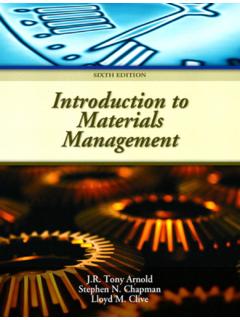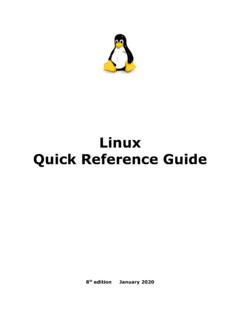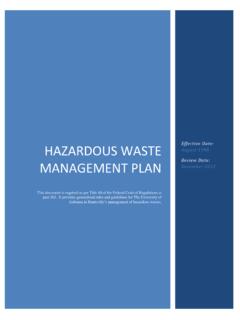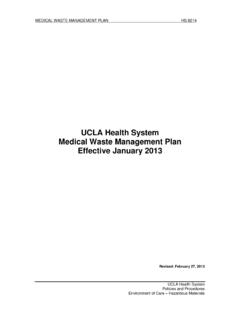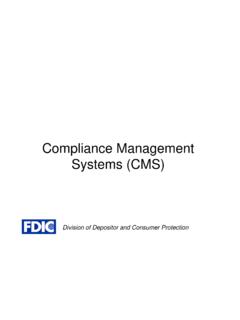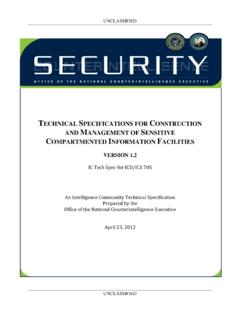Transcription of Introduction to Materials Management - Crans
1 Upper Saddle River, New JerseyColumbus, OhioIntroduction to MaterialsManagementSIXTH EDITIONJ. R. Tony Arnold, , CFPIM, CIRMF leming College, EmeritusStephen N. Chapman, , CFPIMN orth Carolina State UniversityLloyd M. Clive, , CFPIMF leming CollegeEditor in Chief:Vernon R. AnthonyAcquisitions Editor:Eric KrassowEditorial Assistant:Nancy KestersonProduction Editor:Louise N. SetteProduction Supervision:GGS Book ServicesDesign Coordinator:Diane ErnsbergerCover Designer:Jeff VanikProduction Manager:Deidra M. SchwartzDirector of Marketing:David GesellMarketing Manager:Jimmy StephensMarketing Assistant:Alicia DysertThis book was set by GGS Book Services. It was printed and bound by R. R. Donnelley & Sons Company. Thecover was printed by Phoenix Color 2008, 2004, 2001, 1998, 1996, 1991 by Pearson Education, Inc., Upper Saddle River, New Jersey Prentice Hall. All rights reserved. Printed in the United States of America. Thispublication is protected by Copyright and permission should be obtained from the publisher prior to anyprohibited reproduction, storage in a retrieval system, or transmission in any form or by any means, electronic,mechanical, photocopying, recording, or likewise.
2 For information regarding permission(s), write to: Rights andPermissions Prentice Hall is a trademark of Pearson Education, is a registered trademark of Pearson Hall is a registered trademark of Pearson Education, Education Education Australia Pty. LimitedPearson Education Singapore Pte. Education North Asia Education Canada, Educaci n de Mexico, de Education JapanPearson Education Malaysia Pte. 9 8 7 6 5 4 3 2 1 ISBN-13: 978-0-13-233761-8 ISBN-10:0-13-233761-4 Introduction to Materials Managementis an introductory text written for students incommunity colleges and universities. It is used in technical programs, such as indus-trial engineering and manufacturing engineering; in business programs; and by thosealready in industry, whether or not they are working in Materials text has been widely adopted by colleges and universities not only inNorth America but also in other parts of the world.
3 APICS The Association forOperations Management recommends this text as the reference for certificationpreparation for various CPIM examinations. In addition, the text is used by produc-tion and inventory control societies around the world, including South Africa,Australia, New Zealand, Germany, France, and Brazil, and by consultants who pre-sent in-house courses to their to Materials Managementcovers all the basics of supply chain man-agement, manufacturing planning and control systems, purchasing, and physical dis-tribution. The material , examples, questions, and problems lead the student logicallythrough the text. The writing style is simple and user-friendly both instructors andstudents who have used the book attest to the sixth edition, we have added the following: More content on Theory of Constraints (Chapter 6) More content on supply chains (Chapter 7) More content on lean production (Chapter 15) Content on the use of technology in purchasing and warehousing (Chapters 7, 12) The effect of global logistics and reverse logistics (Chapter 13) Six Sigma and QFD (Chapter 16) Small case studies at the end of several chapters PowerPoint slides to accompany all the chapters (an online resource forinstructors)iiiPREFACEivPrefaceIn addition, we have retained several features from previous editions.
4 Margin icons to note key concepts Key terms listed at the end of each chapter Example problems within the chapters Chapter summaries Questions and problems at the end of each chapterAPPROACH AND ORGANIZATIONM aterials Management means different things to different people. In this textbook, Materials Management includes all activities in the flow of Materials from the supplierto the consumer. Such activities include physical supply, operations planning and con-trol, and physical distribution. Other terms sometimes used in this area are businesslogisticsandsupply chain Management . Often, the emphasis in business logistics is ontransportation and distribution systems with little concern for what occurs in the fac-tory. Whereas some chapters in this text are devoted to transportation and distribu-tion, emphasis is placed on operations planning and and operations are managed by planning and controlling the flowof Materials through them and by using the system s resources to achieve a desiredcustomer service level.
5 These activities are the responsibility of Materials manage-ment and affect every department in a manufacturing business. If the materialsmanagement system is not well designed and managed, the distribution and manufac-turing system will be less effective and more costly. Anyone working in manufacturingor distribution should have a good basic understanding of the factors influencingmaterials flow. This text aims to provide that defines the body of knowledge, concepts, and vocabulary used in pro-duction and inventory control. Establishing standard knowledge, concepts, andvocabulary is essential both for developing an understanding of production andinventory control and for making clear communication possible. Where applicable,the definitions and concepts in this text subscribe to APICS vocabulary and first six chapters of Introduction to Materials Managementcover the basics ofproduction planning and control.
6 Chapter 7 discusses important factors in purchasing and supply chain; Chapter 8 discusses forecasting. Chapters 9, 10, and 11look at the fundamentals of inventory Management . Chapter 12 discusses physicalinventory and warehouse Management , and Chapter 13 examines the elements of dis-tribution systems, including transportation, packaging, and material handling. Chapter14 covers factors influencing product and process design. Chapter 15 looks at thephilosophy and environment of just-in-time and lean production and explains howoperations planning and control systems relate to just-in-time and lean 16 examines the elements of total quality Management and Six Sigma INSTRUCTOR RESOURCESTo access supplementary Materials online, instructors need to request an instructoraccess code. Go to , click the Instructor Resource Centerlink, andthen click Register Todayfor an instructor access code. Within 48 hours after regis-tering you will receive a confirming e-mail including an instructor access code.
7 Onceyou have received your code, go to the site and log on for full instructions on down-loading the Materials you wish to and encouragement have come from a number of valued sources, among themfriends, colleagues, and students. We thank the faculty of other colleges and the manymembers of APICS chapters who continue to offer their support and helpful thanks to those who reviewed the fifth edition and provided suggestions for thesixth edition, including members of the APICS Basics of Supply Chain ManagementCertification Committee: Jim Caruso (Chair) of Tyco Healthcare; Carol Bulfer,Parker Hanninfin Corp.; William Leedale, IFS; and Angel Sosa, University of PuertoRico at Bayamon. Academic reviewers included Sheila E. Rowe, North Carolina A&TState University; David Lucero, Greenville Technical College; Floyd Olson, UtahValley State College; Ralph G. Kauffman, University of Houston Downtown;Ronald J. Baker, Shoreline Community College; and Richard E.
8 Crandall, AppalachianState Arnold thanks his wife, Vicky Arnold, for her assistance throughout theyears of writing and revising this text, and Steve Chapman thanks his wife, Jeannine, forher support as well. Lloyd Clive thanks his wife, Kathleen, for her continued , this book is dedicated to those who have taught us the most our R. Tony Arnold, Professor Emeritus, CFPIM, CIRMF leming CollegePeterborough, OntarioStephen N. Chapman, , CFPIM, Associate ProfessorDepartment of Business Management , College of ManagementNorth Carolina State UniversityRaleigh, North CarolinaLloyd M. Clive, CFPIMC oordinator Materials Management and DistributionSchool of BusinessFleming CollegePetersborough, OntarioThis page intentionally left blank CHAPTER 1 Introduction to Materials Management 1 Introduction 1 Operating Environment 2 The Supply Chain Concept 5 What Is Materials Management ? 10 Supply Chain Metrics 15 Summary 17 Key Terms 17 Questions 17 Problems 18 CHAPTER 2 Production Planning System 20 Introduction 20 Manufacturing Planning and Control System 21 Sales and Operations Planning 26 Manufacturing Resource Planning 28 Enterprise Resource Planning 29 Making the Production Plan 30 Summary 42 Key Terms 42 Questions 43 Problems 44 CHAPTER 3 Master Scheduling 49 Introduction 49 Relationship to Production Plan 50viiCONTENTS viiiContentsDeveloping a Master Production Schedule 53 Production Planning, Master Scheduling, and Sales 60 Summary 67 Key Terms 67 Questions 68 Problems 68 Case Study.
9 Acme Water Pumps 76 CHAPTER 4 material Requirements Planning 77 Introduction 77 Bills of material 81 material Requirements Planning Process 89 Using the material Requirements Plan 102 Summary 107 Key Terms 108 Questions 108 Problems 109 Case Study: Apix Polybob Company 123 CHAPTER 5 Capacity Management 125 Introduction 125 Definition of Capacity 125 Capacity Planning 127 Capacity Requirements Planning (CRP) 128 Capacity Available 130 Capacity Required (Load) 135 Scheduling Orders 138 Making the Plan 141 Summary 142 Key Terms 143 Questions 144 Problems 144 Case Study: Wescott Products 149 CHAPTER 6 Production Activity Control 153 Introduction 153 Data Requirements 157 Order Preparation 159 Scheduling 159 Load Leveling 166 Scheduling Bottlenecks 167 ContentsixTheory of Constraints and Drum-Buffer-Rope 170 Implementation 172 Control 174 Production Reporting 180 Summary 181 Key Terms 181 Questions 181 Problems 183 Case Study: Johnston Products 189 CHAPTER 7 Purchasing 191 Introduction 191 Establishing Specifications 195 Functional Specification Description 198 Selecting Suppliers 200 Price Determination 204 Impact of material Requirements Planning on Purchasing 207 Expansion of Purchasing Into Supply Chain Management 209 Some Organizational Implications of Supply Chain Management 211 Key Terms 212 Questions 212 Problems 213 Case Study: Let s Party!
10 214 CHAPTER 8 Forecasting 216 Introduction 216 Demand Management 217 Demand Forecasting 218 Characteristics of Demand 218 Principles of Forecasting 221 Collection and Preparation of Data 222 Forecasting Techniques 223 Some Important Intrinsic Techniques 224 Seasonality 229 Tracking the Forecast 233 Summary 241 Key Terms 241 Questions 242 Problems 242 Case Study: Northcutt Bikes: The Forecasting Problem 251xContentsCHAPTER 9 Inventory Fundamentals 254 Introduction 254 Aggregate Inventory Management 255 Item Inventory Management 255 Inventory and the Flow of material 256 Supply and Demand Patterns 257 Functions of Inventories 257 Objectives of Inventory Management 259 Inventory Costs 261 Financial Statements and Inventory 265 ABC Inventory Control 270 Summary 274 Key Terms 275 Questions 275 Problems 276 CHAPTER 10 Order Quantities 281 Introduction 281 Economic-Order Quantity (EOQ) 282 Variations of the EOQ Model 288 Quantity Discounts 290 Order Quantities for Families of Product When Costs Are Not Known 291 Period-Order Quantity (POQ) 293 Summary 295 Key Terms 296 Questions 296 Problems 297 Case Study.
